- [email protected]
- Fayetteville, Georgia
Achromatic – using only black, white, and shades of gray. See also Grayscale. A Wink and A Nod to Grayscale
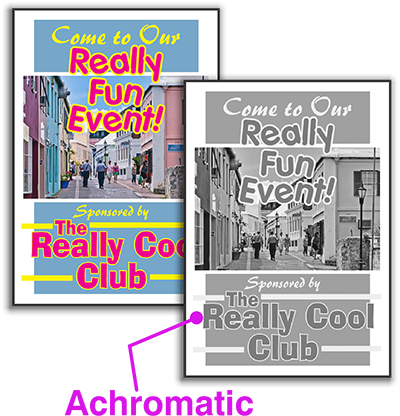
Additive Color – color based on light and light mediums, such as digital screens on computers, phones, etc. Additive colors get lighter as more color is added, moving to white. Compare with Subtractive Color, which is pigment based.

Advance – monies paid to an author or creator of a newly published work by a publisher based upon projected sales of said work. See Royalties.
Agent – a person or entity who is paid by commission and assists writers and artists in the marketing of their works by representing them to potential publishers, galleries, etc. Many traditional publishing houses prefer to work exclusively through agents and representatives and not directly with artists and writers.
Amusement - a state of enjoyment that requires little to no thinking while being passively entertained or occupied. Examples of amusement are television, video games, movies, internet surfing, social media, etc. Compare with Musement. Amusement vs Musement
Anchor Points – in computer graphics programs, the "handles" that surround selected objects, which allow the object to be moved and resized.The Caribbean Man
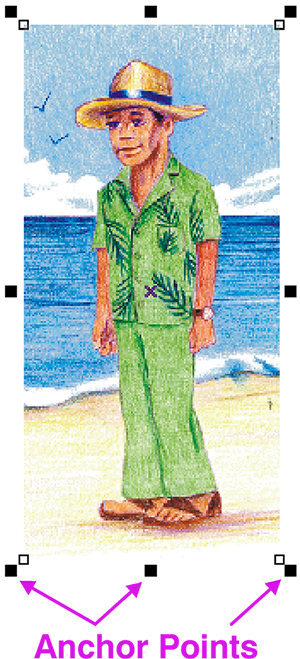
Art Director – the person who heads up and oversees the work of other artists in a studio or art department.
Artist – a very broad term, meaning any person, so taken aback and enamored by the Creation they see around them, that they simply cannot exist without regularly engaging in the pursuit of creating imitations or interpretations of said Creation. These can be in many forms, including flat, two dimensional substrates incorporating pigments in some form; three dimensional sculptures, carvings, moldings; music and vocal renderings in any form and genre; visual story tellings incorporating movement such as dance and video. Be warned however ... these persons need to approached cautiously. They can be very engaging and charming, but, while not particulary dangerous, they can be moody and are generally very intense. They can be tiresome if you interact with them unprepared or for very long periods of time. See also Illustrator, Graphic Artist, Commercial Artist, and Designer.
Author – a writer. Someone who uses written words, selected and arranged to convey thoughts, ideas and narratives, fiction or non-fiction. Similar in meaning to the term Storyteller, the two terms can be used interchangeably. Generally speaking, however, a Storyteller relates their story orally to listeners, while an Author relates their story via the written word to readers. Stories from both can be fact-based from actual events in their own or another’s life, or pure fiction, invented from imagination.
BBindery – the department of a print shop responsible for finishing a job after the printing process is complete. “Finishing” includes scoring, folding, trimming, stapling, binding, drilling, perforating, punching, coiling, numbering, gluing and a myriad of other duties that will turn the flat, printed paper into a book, brochure, business card, flyer, pad, etc.
Blanket – the part of an Offset Printing press which receives the inked image from the Plate, and then presses and transfers the image to the paper Substrate traveling through the press.
Blank Page – a deceptively innocuous tool designed to strike sheer terror into the heart and mind of an unsuspecting writer or artist. WARNING! Not to be wielded carelessly by by the uninformed or inexperienced!! Can be the source of great and terrible mental and emotional anguish, and could be potentially lethal! Keep covered and out of sight when not in use! Can, however, when handled responsibly, result in positive, life-giving Joy for the writer or artist, and positive emotional reactions from readers or viewers.
Bleed – the area of a graphic, color or background on a graphic design that extends beyond the trim line, so that on the finished trimmed printed paper, the graphic, color or background appears to be printed right up to the edge of the paper. The bleed area is generally 1/16” - 1/4” beyond the trim line on the art file. A printed piece can bleed on one or any number of sides. A Full Bleed is a bleed that extends to all trimmed edges of the printed piece.
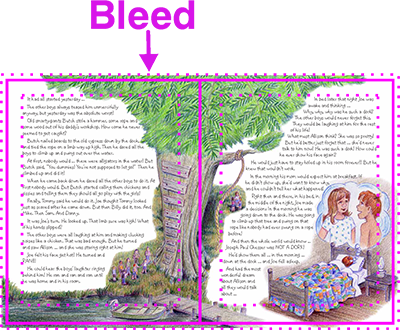
Block – also referred to as Writer's Block or Creative Block. Refers to what's happening in a creative's brain when the ideas stop flowing and they just don't know what to write/draw/sculpt/compose, etc. next.
Blocking In – in beginning a drawing, when an artist uses light lines to rough in basic shapes, sizes and positions of elements in a drawing in preparation for more finished steps.
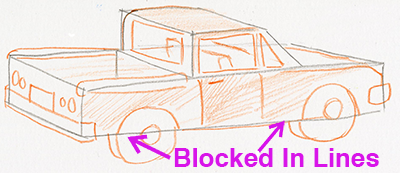
Blog – a written, ongoing narrative published on a website at regular intervals, designed to relay information on a given topic and presented in such a way so that both the writer and the reader can interact and exchange thoughts and ideas concerning said topic. Blogging
Blue Line – in pre-computer days, when graphic layouts were assembled on boards with glued-on type and graphics, guidelines were drawn on the board using a t-square and triangle and a light blue colored pencil. When the art board went to the camera room to be photographed to make a negative for burning the plate for the printing press, the blue lines would be invisible to the film and wouldn’t show. Cool beans!!
BMP – a bitmap file containing black and white or color raster images; can generally be opened or imported in any software program.
Bristol Board – a type of drawing paper made into a heavier weight by pressing layers of lighter weight paper together. 2-ply is 2 sheets pressed together, 3-ply is 3 sheets, etc. It is available with different finishes, smooth, semi-smooth and vellum for different types of mediums, wet and dry.
Burn – (a) a term used to describe the process of preparing of a plate for an Offset Printing press. The Plate is coated with a photo-type emulsion. Film with a negative image of art to be printed is held in contact with the plate in a vacuum frame, then exposed to a bright light that hardens – “burns” – the emulsion through the clear areas of the film. The unexposed ares of emulsion are washed away , leaving the hardened area on the plate, which is then attached to the printing press for the Offset Printing process. (b) A similar process is used in Screen Printing where the screens are coated with emulsion and film positives are used to "burn" and expose areas of the screen where the emulsion will harden, leaving open areas where the ink will pass through during the printing process.
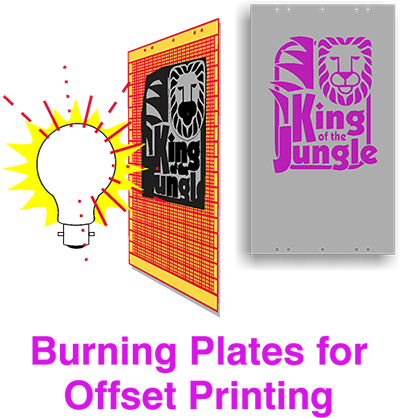
Burnish – in colored pencil, after two or more layers of color, the final layer is applied with heavy pressure, resulting in more vibrant color. Burnishing is generally done with a lighter color for the final, heavier layer, but can be done with the same color for all layers.
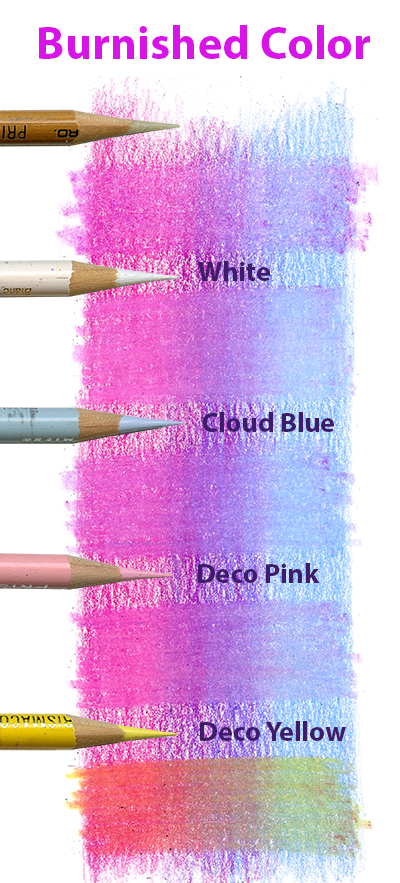
Butt Registration – in graphics prepared for print production, where two or more colors meet at their edges, with no overlap. Butt registration is most commonly used in traditional screen printing methods for textile printing like t-shirts, sweats, sportswear, etc. See also Trap Registration.
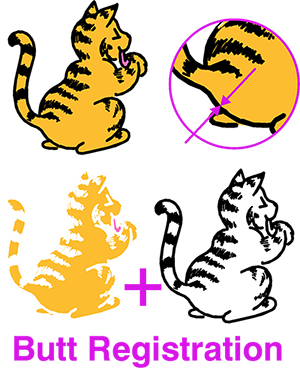
C
Camera – once upon a time print shops had their own “camera room” which housed a room-sized camera and a dark room. The graphics were photographed and the film Negatives were developed and used to Burn the plates for the Offset Printing process, or film Positives for the Screen Printing process.
Center Fold – center of a Saddlestitched book where the pages are bound together.
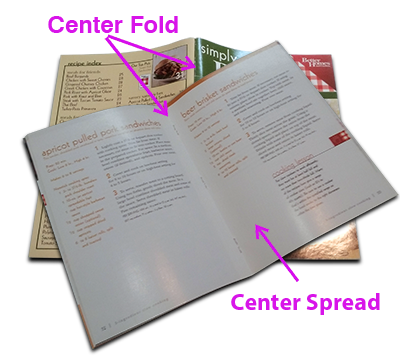
Center Spread – in folded and Saddlestitched books and booklets, the exact middle Spread, left and right consecutive facing pages, sitting beside each other on the same sheet of paper.
CGI – Computer Generated Image. A film industry term for images and special effects that are generated with computer software and combined with filmed, live action to enhance or complete scenes. For example adding dinosaurs or fictitious creatures, natural disaster effects, enhanced explosions, etc.
Channel – in computer software programs like Photoshop, there will be a channel for each color or part of the mode you are working in. For example, in RGB mode, there are three channels: red, green and blue. In CMYK mode, there are four channels: cyan, magenta, yellow and black. Grayscale mode has only one channel: black. In any mode, each channel can be modified separately of the other channels.
Character Arc - in storytelling, refers to the process and changes a character goes through from beginning to end: how they start out, what struggles they face and overcome, and finally how they end up ... changed or improved in some important way. See A Real Definition ... Finally!
Chloe – the proper name of one particular black cockerpoo. Passed away January 2, 2019 at age 16. Will forever live and grace the pages of a particular website, www.sherryamitcham.com. Chloe’s name is synonymous with faithful companion, and 20 good, hard belly laughs every day. Her name can also be used as a verb, as in: “Oops! I Chloed!” Which means you got so excited at being informed of an upcoming walk or ride, that you leapt for joy ... forgetting you were under a table at the time ... or some other such goofy blunder.

Client – an assignment, usually in the form of a person or persons, who God sends your way when He has something important He needs them to do, and, in order to accomplish the task, they require the kind of assistance that He has gifted and enabled you to provide. The world will tell you that the primary purpose for this cooperation between the two of you is monetary reward so that you will be able to provide for and sustain your physical life and family. We know better ... while physical sustenance is necessary and important, far more valuable is the deep and unfathomable Joy that results from being and doing what He designed you to be and do and to see the resulting benefits that befall your client. If you perform your assignment well, the client will in all probability also experience this life-giving joy, which is transferable between persons and, in an unharmful manner, is totally contagious.
CMYK – an acronym of the colors Cyan, Magenta, Yellow and blacK, the four colors, pigment based, used in four-color process printing.
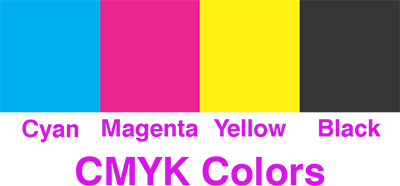
CMYK Color Wheel – a color system used by printers for reproducing full color images on printed and published materials. CMYK is an acronym for Cyan, Magenta, Yellow and blacK. Cyan, magenta and yellow can be mixed in various proportions to reproduce any color. Black is added to darken and add sharpness and contrast. The Primary Colors on the CMYK Color Wheel are Cyan, Magenta, and Yellow. The Secondary Colors on this wheel are Red, Green and Blue, the RGB colors. See also Pantone Matching System. Color 101
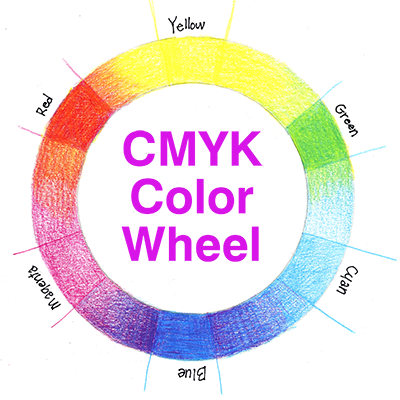
Coated Paper - refers to the finish on some papers in order to make the paper smoother, heavier, shinier or more opague. Coatings can be matte, gloss or semi-gloss. The coating seals the surface of the paper so that wet mediums do not soak into the paper, making it ideal for pen and ink renderings and for offset printing. Color images printed on coated paper will be brighter, making it an ideal choice for the colorful inside pages of picture books. See also Uncoated Paper.
Coiled Cover – a type of book binding where the inside edges of the pages are trimmed to size and hole punched and inserted with rings or spirals made of plastic or metal.
Colored Pencil – a marking instrument and gift placed into the hands of mankind by God for the sole purpose of allowing puny mortals to lavish colorful, wax-based pigment all over their pitiful little two dimensional imitations of His Creation. See also Prismacolor.
Color Separations – manually or electronically providing a printer with each color or page needed for a producing a printed image. Also referred to as Separations
Color Wheel, Traditional – a tool used by artists for the pupose of choosing and planning pigment-based color selections for art and graphic design. The colors on this tool are arranged based on the natural arrangement of colors when white light is broken down into the various spectrums. The Primary Colors on the Traditional Color Wheel are Red, Blue and Yellow. The Secondary Colors on this wheel are Orange, Blue and Purple. See the CMYK Color Wheel for the color model used in the printing industry.
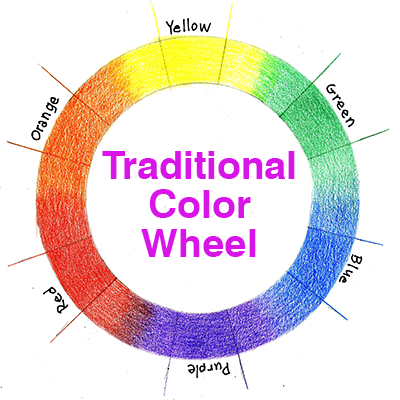
Commercial Artist – a dated term for a Graphic Artist whose expertise is layout and design utilizing typed copy and graphic elements, drawn or photographed, for the end purpose of printing or publishing. The term Commercial Artist was generally used in pre-computer days, and could also encompass other skills such as hand-lettering, marking up layouts, etc. See also Artist, Graphic Artist, Illustrator, and Designer.
Complementary Colors – on the Traditional Color Wheel, any two colors that sit exactly opposite of each other. A mixture of two complimentary colors will neutralize both, resulting in gray. See also Split Complementary Colors.
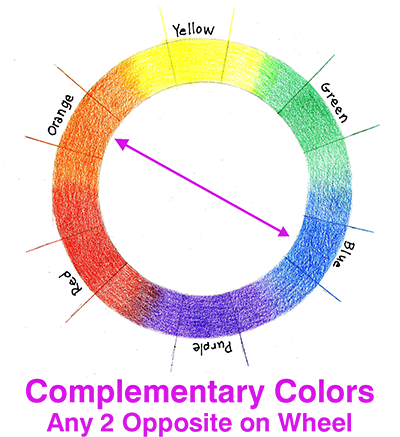
Computer Generated Image – CGI. A term used typically in the film industry for images and special effects that are generated with computer software and combined with filmed, live action to enhance or complete scenes. For instance adding dinosaurs or fictitious creatures, natural disaster effects, space scenes, enhanced explosions, etc.
Convert to Curves – see also Create Outlines. In computer graphics software programs, when typed copy is modified so that it is no longer type, but the computer sees it as graphic shapes. This is important when sending graphic files to another computer which may not have the fonts installed that were used in the original typesetting, forcing the receiving computer to substitute another font which can result in shifted and ruined layouts.
Copyright – declared ownership and legal protection from theft for creators of published, original works like art, music, writing, etc.
Cover – the protective outside of a book using one of several binding methods. See Perfect Bound, Hardcover, Coiled Cover, Wrap Around Cover and Saddlestitch.
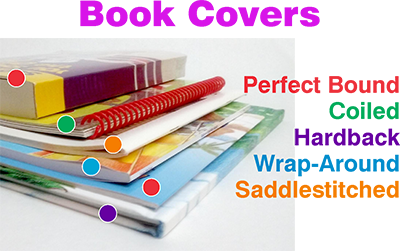
Create Outlines – see also Convert to Curves. In computer graphics, when typed copy is modified so that it is no longer type, but the computer sees it as graphic shapes. This is important when sending graphic files to another computer which may not have the fonts installed that were used in the original typesetting, forcing the receiving computer to substitute another font which can result in shifted and ruined layouts.
Creative Block – also referred to as Block or Writer's Block. Refers to what's happening in a creative's brain when the ideas stop flowing and they just don't know what to write/draw/sculpt/compose, etc. next.
Creativity – the ability to imagine and produce original work and/or solutions for practical or aesthetic purposes See also Artist, Imagination and Pony.
Creep – in bound books, as the number of pages and book thickness increases, the printed images appear to travel or "creep" towards the gutter/center of the book, making images and text on the outer pages difficult to see/read. To compensate, the images are shifted slightly away from the center, shifting incrementally as the number of pages increase, giving the appearance that they are all aligned and making the book easier to read.
DDesigner – a type of graphic artist who specializes in the selection and arrangement of elements to be displayed, printed, published, etc. Designers may or may not possess artistic ability, but they do possess a keen eye for aesthetically pleasing arrangement and layout, form and color. “Designer” is a broad term that can be applied, not only to the graphics industry, but to almost any profession that produces a product or service: auto design and manufaturing, interior decorating, the food industry, the clothing industry, architecture, etc. ... any industry or service whose product requires beauty along with functionality, and entails visual displays and presentations of said procucts or services. See also Artist, Graphic Artist, Illustrator, and Commercial Artist.
Desktop Publishing – production of published works from a personal computer and software.
Diad Color Scheme – using 2 colors that are 2 colors apart from each other on the Traditional Color Wheel. Examples: red-orange; green-blue; purple-red.
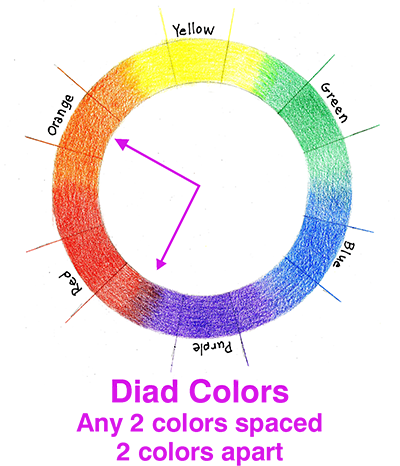
Digital – electronically produced or viewed.
DPI – Dots Per Inch. See Halftone. In offset printing, the measurement that describes the quality of a halftoned picture. DPI tells you that in the physical space of one inch, that number of dots will fit. For example: 300DPI means the dots are sized so that a row of 300 dots will fill into a one inch length. A photo printed with 300 DPI will be lower quality than a photo printed with 1800 DPI.
Dummy – A mock up of a book, used as a visual aid in the planning or production phase, to help the artist or printer know or determine what images or copy will fall onto each page, to demonstrate what the final book will look like and to aid in the production process. Dummy books can be full size or smaller just for reference.
Dust Cover – The printed paper wrapped around a hardcover book to protect the cover. Also called a "dust jacket".
EEbook – a written, published work designed and intended to be viewed and read digitally on an electonic device, as opposed to being printed on paper like a traditioanal book.
Editor – a person who reviews works prepared for publishing, checking not only for gramatical, spelling, and factual accuracy, but also for writing structure and how well the writer is communicating thoughts and concepts to the reader. Editors at traditional publishing houses also determine if submitted manuscripts will be accepted for publication.
Eternity – the perceived time frame between receiving the Inspiration for a great story to offer to the world, and holding the actual book in your hands.
FFacebook – a social media platform designed specifically to help you engage friends, family, clients, colleagues and total strangers world-wide with images and comments about your personal life, your work life, your political views, your thoughts and opinions about life in general, and what you are currently eating while informing, entertaining, educating, and generally enraging and collecting as many friends, hits, likes and comments as you can possibly collect. If you are a cat owner, it is imperitive that you have a Facebook account. For dog and cockatiel owners, it's merely highly recommended. Ditto for Instagram, Twitter and YouTube. Facebook
Family – the person(s) you occasionally bump into, who seem to always be there in that place where you live, who support you, celebrate your victories, mourn with your struggles, and who will always wait patiently while you write just one more paragraph or fill in just one more area with color. See also Friends.
Fantasy – a fiction narrative or artwork that is based soley on imagination, and may or may not bear any resemblance to real world facts, experiences or circumstances. See Fiction.
Fiction – a Narrative or artwork that is based on imagination, but still retains elements or facts related to real-world experiences and circumstances. See Fantasy.
Film Postive – see Positive.
Fold Marks – on artwork set up for printing, dashed lines that will print outside the image area to indicate to the bindery department where to fold the printed pages. See also Printer's Marks, Trim Marks, and Register Marks.
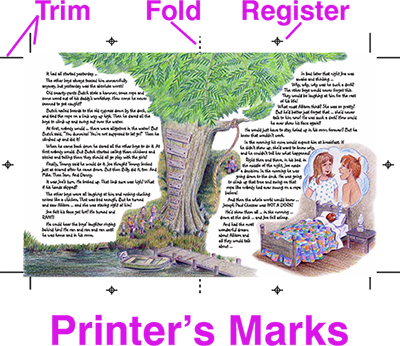
Font – a specific style of a typeface, also available in different weights and versions; for instance, bold, italic condensed, etc. A font together with its various versions is called a "Family". with See also Typeface, Serif, and Sans Serif.
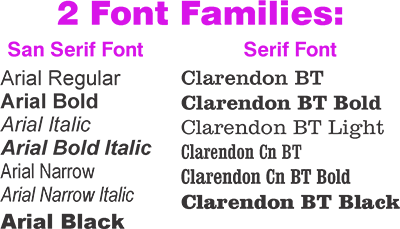
Four Color Process – when printing in color, digital or offset, the graphics are separated in such a way that by only printing the colors cyan, magenta, yellow and black – CMYK – the resulting print will appear to be in full color. See Halftone.
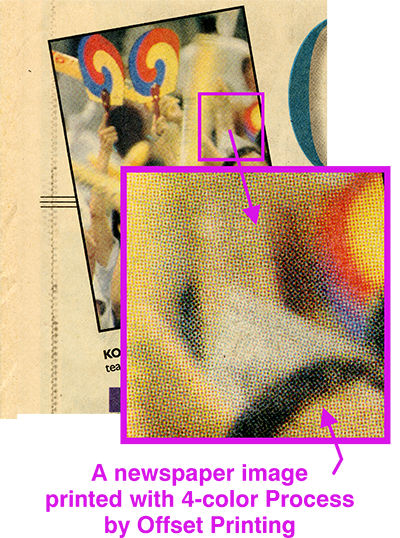
Friends – the wonderful people you love and spend time with who will laugh and cry with you during your times of victory and struggle, either in your personal or professional life. They will always be there to cheer you on, advise you, and sometimes warn you when needed. See also Family.
Full Bleed – is a bleed that extends to all trimmed edges of the printed piece. See Bleed.
GGhostwriter – an author who is hired and paid to write material that will be published under another author's name.
Giclée - a reproduction of fine art which is printed on high quality art paper using a high-end ink jet printer. Giclées are especially excellent for prints and reproductions of watercolors and pencil art, but also for oils and acrylics, as these can be printed on canvas. Superior to offset printing and can be used for small runs ... as few as one print.
Gradient – in graphic art, an area of color(s) on a graphic that is not solid, but fades from solid color to lighter hues of the same color, or blends from one color to another or other colors.
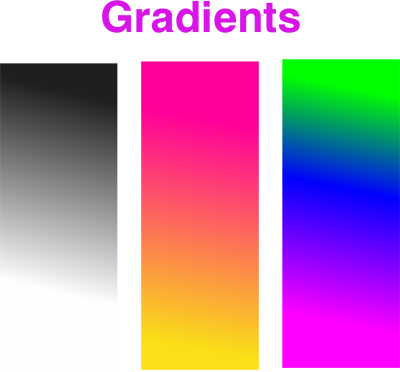
Graphic Artist – an artist whose expertise is layout and design utilizing typed copy and graphic elements, drawn or photographed, generally utilizing computer software, for the end purpose of printing or publishing via print or web-based media. See also Artist, Commercial Artist, Illustrator, and Designer.
Grayscale – an image that is colorless, black and white, or varying values or shades of black.
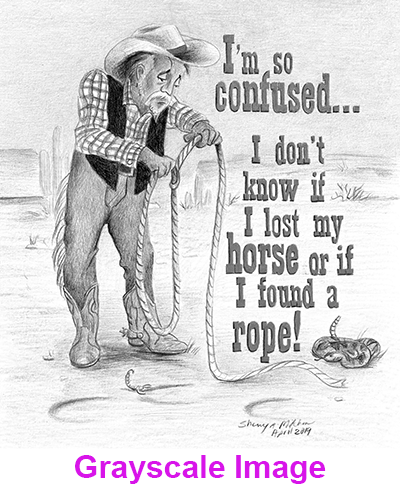
Gripper – the part of a printing press which literally “grabs and grips” the edge of the paper, pulling it into the printing press toward the blanket where the image is pressed onto the paper. 1/4” from the leading edge of the paper – the edge that heads into the press – is generally required for the gripper, and no part of the printed image, including bleed and trim, fold, score, registration markings, should be in that area.
Gutter – the area at the center of a book where the individual pages are joined together and attached to the outside cover. Extra margin is needed in this area to give room for graphics and type that need to be visible over the curve in the page that occurs when the book is open.
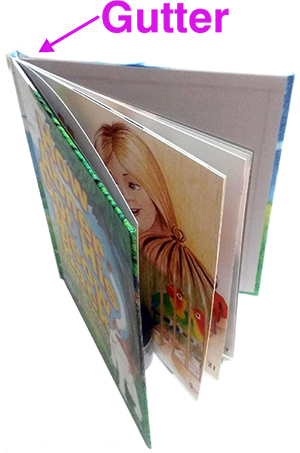
H
Halftone – In offset printing, the printing press must print solid ink. It cannot print gradients or shades of color. So the image is reduced to a series of tiny dots, smaller dots in lighter areas, larger dots in darker areas. These dots are measured by how many full size dots will sit in an inch. A 100 DPI (a row of 100 dots will fit into a one inch length) halftone will be much coarser than a 1800 DPI halftone (a row of 1800 dots will fit into a one inch length). See DPI.
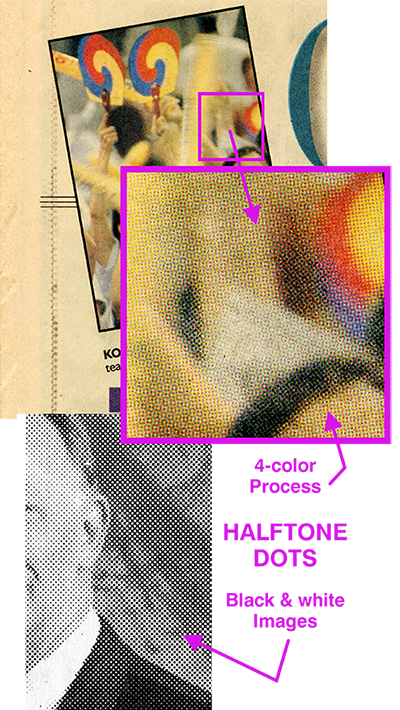
Hardcover – a book with a stiff cover, generally heavy cardboard wrapped with printed, lighter paper glued to it. See also Dustcover, Softcover and Paperback.
Hardware – the physical, working components of a computer or other digital device. See Software.
Headliner – (a) the main title on an article, typed copy or graphic layout or advertisment. (b) “Headliner” is also an old-fashioned newspaper term, referring to a specific story in a specific edition that was considered the main, most important story in that edition of the newspaper. (c) in pre-computer days, a machine designed to set single lines of type, “headlines”, to then be used in paste-ups and layouts of copy to be printed. It consisted of a large clear plastic disc on which the characters and letters were printed in reverse – clear characters with a black background. The disc was rotated to the desired letter/character, aligned by eye, and a light exposed each letter onto a strip of film inside the machine that was continually advanced until the entire line of type was exposed. Inside the machine, as the strip of exposed film advanced, it was carried through a tray of developer and a stop bath that developed the film, giving the operator a strip of typed copy. Once set and developed, the strip was rinsed with clear water, allowed to dry, and then sent to the paste-up artist.
Homepage – the opening page of a website designed to welcome visitors to the site and direct them to the site’s various pages, articles and information.
Hyperbole – in writing and speaking, an expression or description of a situation or a person or thing that is so extremely exaggerated that it is obviously untrue or impossible, but it helps the writer/speaker to convey the strong emotions that were evoked. For example "I'm so hungry, I could eat a horse!" or "There must have been a million people in the store today, and they were all in front of me in the check out line!"
IIllustrator – a type of Artist whose specific area of expertise is to take a written narrative and interpret and expand its meaning through visual images, utilizing line, form and color. See also Artist, Designer, Commercial Artist, and Graphic Artist.
Image Shift – in bound book production, to allow for an area beyond the center margin for gluing or sewing interior pages together, the image on each page needs to shifted left or right in the direction away from the center. This is usually at least 1/8”, but on thicker books with many pages, and depending on the binding method used, can increase incrementally from the center page to the outer pages.
Image Setter – a high-end digital printer, used in Offset Print shops, in conjunction with select graphics software, to print out Color Separations onto film negatives that are then used to burn the images on the plates.
Imagination - the ability to use one's mind to think up fictitious senarios, characters or circumstances, based or not on facts, in order to entertain or solve real-life problems. See also Artist, Creativity and Pony.
Inspiration – an elusive quality of unknown origins. It cannot be beckoned, cannot be forced, cannot be captured. Like the wind, you cannot perceive from where it comes, but you will always know when it arrives. It can appear at any time, in any place. If not utilized upon its arrival, it can vaporize just as instantly and mysteriously as it came. Stay alert!
Instagram – a social media platform. See Facebook.
Intermediate or Tertiary Colors – one Primary Color and one Secondary Color mixed together. Examples: red-orange, blue-purple, yellow-green etc.

Invert – see Reverse Image.
ISBN – International Standard Book Number. A number assigned to published books that identifies the author, publisher and specific form of the published book. An e-book version and a standard version of the same book will have 2 different ISBN's. See also ISSN.
ISSN – International Standard Serial Number. A number that identifies particular periodical or serial publications such as newspapers, magazines, journals, etc. See also ISBN.
JJourneyman Printer – a printer who is exceptionally skilled, knowledgeable and experienced in his craft.
Joy – a elusive quality that cannot be purchased or captured, and is not dependent on your outward circumstances. It is not happiness, which can be shallow, subjective, and fleeting. You can be suffering mightily in this life, and still be filled with joy. Joy is the direct result and consequence of being in a personal relationship with your Creator and being and doing on this planet what your Creator designed you to be and do, thus fulfilling your destiny. To see a demonstration of joy in action, click here. See also Client.
JPG or JPEG – a digital file format containing raster images, JPG's are especially useful for web graphics, because the files are smaller which means web images will load faster. Most photo files from digital cameras are JPG.
Justification – refers to the alighment of typed copy, left, right or centered, etc.
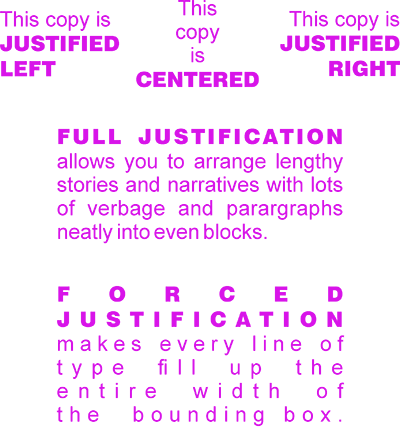
K-L
Kerning – the spacing between characters in typed copy. See also Font, Typeface, Leading, Serif, and Sans Serif.

Laminate – to wrap a document between layers of a protective material, usually plastic which is then fused toghter around the edges.
Lantz, Walter Benjamin – An American cartoonist and animator. Born April 27, 1899, died March 22, 1994. Creator of the cartoon character, Woody Woodpecker, and The Woody Woodpecker Show in the 1940-60’s. A charming TV personality who was responsible for permanent eye damage to many artists in their childhood with his daily drawing demos, causing them to see their world differently ... which actually ended up not being such a terrible life skill for them to have! The Grand Illusion
Layout – the arrangement of graphic elements and/or typed copy on a page.
Leading – the vertical spacing between the baselines of lines of typed copy. See also Font, Typeface, Kerning, Serif, and Sans Serif.
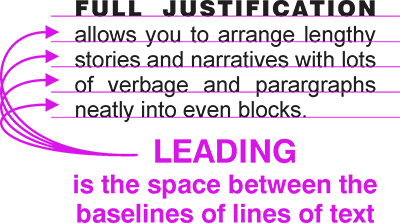
Line Art – a graphic that is totally black and white, no gradients or shades of gray, generally produced by drawing with pen and ink or drawn into a computer with a tablet or with graphics software.
LPI – Lines Per Inch. See also DPI and PPI.
MManuscript – the typed out file or hard copy of a narrative that an author sends to a Publisher, Editor, Agent, Illustrator, etc., for consideration, editing or review for publishing or processing.
Margin – the space between the edge of a page and the outer limits of typed copy or graphics.

Mark Up – writen marks or notes on a proof by an editor or an art director that instructs the graphic artist how to layout or correct a document.
Masking Sheet – in offset printing, a yellow paper with a pre-printed grid, that is used to align film negatives in the correct position, so that when the printing Plate is burned for the press, all copy will be in the correct position on the Plate for printing on the paper.

Media – any one of a variety of electronic or print vehicles through which information is relayed, transmitted, broadcast, etc. Examples include news organizations, radio, television, web, video, etc.
Medium – refers to the selected type of pigments or materials an artist uses to produce an artwork, like oils, acrylics, watercolor, pencil, etc.
Mirror Image – a duplicate image that has been flipped either left to right or top to bottom. See also Reverse.
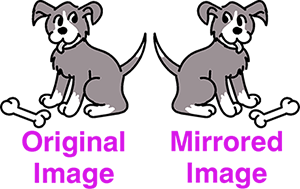
Mode – refers to the color or grayscale model of an open file in computer software photo-retouching programs like Photoshop. Normally RGB mode will be the default mode, which can then be converted to another color mode like CMYK, or the color can be discarded to work in Grayscale. In any mode, there will be a Channel for each color or part of the mode you are working in.
Monochromatic – using only one color and shades of that color. Compare to Achromatic.
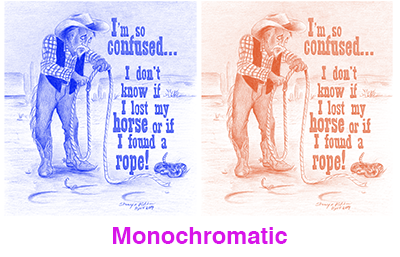
Musement - a state of enjoyment that requires full participation mentally and/or physically. Examples of musement are reading, engaging in hobbies and crafts, creating art, live, face-to-face conversing with other humans, etc. Compare with Amusement. Amusement vs Musement
NNarrative – a story, generally written, but also can be related orally. A narrative can be Fiction or Non-fiction.
Negative – (a)refers to the film used to Burn the Plates for the Offset Printing process. It is a reverse image of what the final print will be ... the clear areas of the film get exposed on the plate emulsion and those are the images that will actually print. For the Screen Printing process, film Positives are used to Burn the Screens. (b) In art or photography, a reversed image.
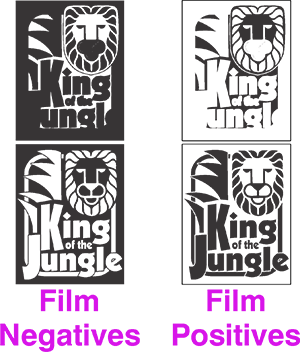
Non-fiction – a Narrative that is based on facts or truth.
Non-Proportionate – see also Proportionate and Scale. When either reducing or enlarging the size of a graphic or an image, to change the relationship between the height and the width. The Caribbean Man
OOffset Printing – a term that describes the action on a printing press, because the image on the Plate does not get printed directly onto the paper. Instead, when the ink goes onto the Plate image, it is then transferred to the Blanket, which then prints or “offsets” the image to the paper.
Outline - a tool writers use to plan out what they want to say in an article, story, book, etc. before actually writing it.
Overlay – see Paste Up. In pre-computer days, when laying out copy and graphics to be printed, if the printed piece would be more than one color, the main color type/graphics would be glued to the board. A sheet of acetate would be taped on top of the board and any copy to be printed in another color would be glued to the acetate in proper alignment to the type/graphics on the base. This was called an overlay. A separate overlay was needed for each additional color.
PPage Break – when laying out a narrative into book form, where the copy will end on a page, and then resume again on the following page.
Paginate – (a) the action of numbering pages in a document or adding page numbers. (b) The action of distributing and arranging typed copy, photos, illustrations, diagrams and charts, etc. of a narrative onto the separate pages of a book being designed and/or printed.
Pantone Matching System – a color-matching system developed by Pantone LLC in the 1960’s, designed for the offset printing industry. It enables accurate color mixing and matching of printing inks industry wide. It is based on the CMYK Color Wheel, using cyan, magenta, yellow and black ink colors in order to reproduce full color images in printing. The PMS Spot Color Model, Coated and Uncoated, is now also standard in computer graphics software right along side RGB, CMYK, and other color models.
PMS Coated Colors – indicates what ink colors, CMYK or Spot colors, will look like on Coated Paper. Inks printed on coated paper sit atop the coating which make the color more vibrant.
PMS Color Bridge – the Color Bridge is a guide that shows what a spot color will look like if reproduced using the 4-color process with cyan, magenta, yellow and black (cmyk) inks. The Bridge gives the "recipe" or the correct percentages of each of the cmyk colors for a particular color. The Bridge will also show what these mixtures will look like when printed on coated and uncoated paper. This is very useful for graphic designers, because these mixtures can be assigned to elements in graphics software, helping both the printer and the designer to know the colors in the final printed art will be accurate.
PMS Color Guide – a guide for printers that enables them to mix ink colors for the press from the base colors – cyan, magenta, yellow and black. The guide also shows them what the final mixed colors will look like when printed on coated and uncoated paper.
PMS Spot Colors – premixed ink colors used in printing presses that are based on the PMS Color Guide .
PMS Uncoated Colors – indicates what ink colors, CMYK or Spot colors, will look like on Uncoated Paper. Inks printed on uncoated paper will absorb into the paper which can sometimes make the color appear slightly dull or muted.
Paperback – a softcover book with a heavy paper cover, but not heavy or stiff enough to be a hardback.
Paste Up – in pre-computer days, graphic layouts to be printed were assembled on boards with blue guiedelines. A typesetter would print out long galleys of type, and the type and graphics which would be cut up, arranged and glued on the boards with blue guidelines. Everything was aligned using t-squares and triangles.
PDF – a digital file format, Portable Document Format, that is used for sending and receiving documents between different computer systems containing typed copy as well as graphic and photographic images. The received documents appear exactly as they were created, making this file format useseful for sending proofs and documents to be printed to others who may not have the software programs that originally were used in the creation of the documents. Vector and raster images are retained in a PDF file, keeping printed images sharp and clean.
Perfect Bound – type of binding used on books with covers that generally involves a one-piece cover wrapped around the outside of a book after inside pages have been assembled together ususally by gluing. The Spine area of the cover is glued to the left edge of the bound inside pages. See Covers.
Perforate – scoring a part of a page so that it can be easily torn away, as with coupons, or parts of an invoice to be mailed with a payment.
Picture Book – typically a book for children, which, as much as the typed copy, relies heavily on images, photographic or artistic, to illustrate and expound upon the narrative.
Plate – a sheet made of metal, paper, or plastic, that is attached to an Offset printing press which has the image to be printed etched or Burned onto it, and that receives the printing ink and then transfers the image to a rubber blanket, which then transfers the image to the paper or substrate being printed.
PNG – a digital file format, Portable Network Graphics, containing raster images. PNG's are higher quality than JPG's, meaning that they are useful for web graphics, but may load a little slower. Unlike a JPG, a PNG will allow you to keep transparent backgrounds behind images.
Pony – a metaphor for the generally intense emotional state of anyone born with any kind of artistic or creative gift(s) or leaning(s), which motivates and propels that person towards creative and artistic endeavors which will allow expression and release of said intense emotions. WARNING!! Failure to express and release these intense emotions via positive creative and artistic endeavors will result in pressure build-up in heart and mind causing intense emotional pain, disillusionment, break down and destruction of interpersonal relationships, and severe depression! Can be fatal! On-going, regular, active creative and artistic expression to release the internal intensity is the only known remedy. On Being Creative
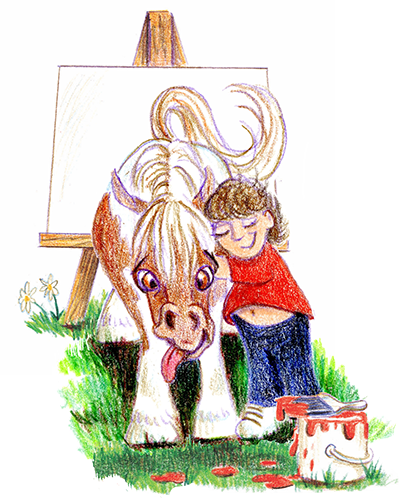
Positive – refers to the film used to Burn the Screens for the Screen Printing process. It is a image of what the final print will be ... the clear areas of the film get exposed on the screen emulsion and those are the images that will actually print. For the Offset Printing process, film Negatives are used to Burn the Plates.

Portfolio – in graphic and fine art, a collection of original art pieces, assembled for the purpose of demonstrating an artist’s skills and abilities, usually with the intent of procurring employment. Can be actual art, reproductions of art, electroinc images or photographic slides.
PPI – Pixels Per Inch. See also Raster, Resolution, DPI, LPI.
Primary Colors – the colors on a Color Wheel, that cannot be made by mixing any other colors. The 3 Primary Colors on the Traditional Color Wheel are red, yellow and blue. On the CMYK Color Wheel the primaries are Cyan, Magenta and Yellow.
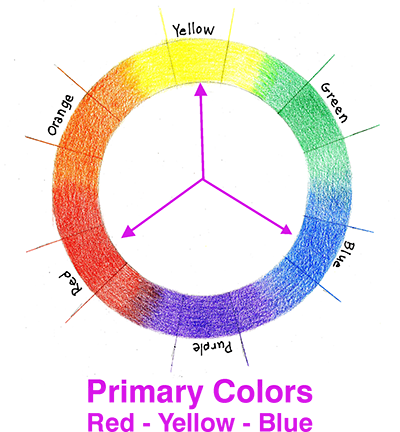
Printer's Marks – on artwork set up for printing, lines and markings that will print outside the image area to help the printer align the plates and indicate to the bindery department where to score/fold/trim, etc. the printed pages. See also Fold Marks, Trim Marks, and Register Marks.

Prismacolor – undisputedly the best choice of one of several commercial brands of wax-based colored pencils. Other artists may disagree ... but they can go get their own websites to have those discussions. On this website, Prismacolor reigns! See also Colored Pencil.
Proof – a digital or printed copy of a proposed document presented to the client or editor for the purpose of proofreading and checking for errors or changes before it is approved for actual printing.
Proofread – reading and scanning typed copy and art elements before printing in order to check for accuracy, mistakes, misspellings, gramatical errors, etc.
Proportionate – see also Non-proportionate and Scale. The relationship between the height and width measurements of an image(s) or graphic(s). The Caribbean Man
Pseudonym – a ficticious name, used generally by authors, that masks their true identity, in order to retain anonymity or personal privacy.
Publish – to make available for public use and viewing a work that is either written and/or visual either through printed means or broadcast in some form.
Publisher – a person or an establishment that purchases the rights to produce, market and sell works by writers and artists who have submitted said works for consideration for purchase. The writer or artist will generally receive name credit and monetary reward through royalties for creating the work, but the work in its product form is the property of the publisher. See also Self Publisher, Traditional Publisher, or Vanity Publisher.
Punch – manually or automatically with a machine, creating holes in pages for the purpose of assembling into notebooks or coil binding. See Coiled Covers, Covers.
Q-RRaster – an image on a screen or monitor that is pixel based, constructed of hundreds or thousands of pixels, depending on the resolution. Resolution is very important when working with raster images, and needs to be considered based on the final application of the image. Generally, raster images that will be printed need to be a minimum of 300 PPI at 100% application dimensions. Images that will be viewed on a monitor or screen, or are web-based need to be 72 PPI or higher. If unsure of the final application, or if the image might be used both ways, it’s usually best to use the higher resolution and reduce the image. Lower resolution images that are enlarged greatly will quickly lose crispness and quality. See also Resolution, Vector Image, PPI, DPI, LPI.
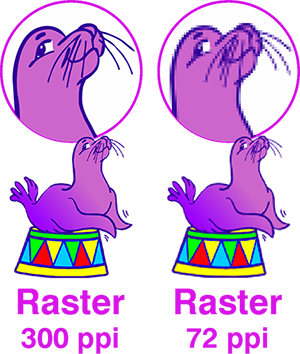
Rasterize – the act of converting a Vector Image into a Raster Image.
Register Marks – on artwork set up for printing, markings that will print outside the image area to help the printer align the plates. See also Printer's Marks, Trim Marks, and Fold Marks.

Registration – aligning the different colors in an art layout or on a printing press. See also Butt Registration, Trap Registration.
Registration Color - 100c100m100y100k. In computer graphics and layouts that will be color-separated in preparation for four-color process print production, apply this color to any marks for registration, trimming, folding or scoring, or notes for the printer. When the computer separates the colors, all marks and notes with registration color applied will appear on each of the four separations.
Rendering – an artistic term referring to the completion of a flat line drawing with any preferred medium through the means of coloring or shading to create the illusion of depth and form.
Resolution – the measurement of the quality of a Raster image based on the number of pixels in the image. A higher number of pixels will result in a higher resolution and a sharper image. For images viewed on screens and monitors, the size and quality of the image will also be affected by the number of pixels that compose the viewing area of the screen or monitor. See also Raster and Vector.
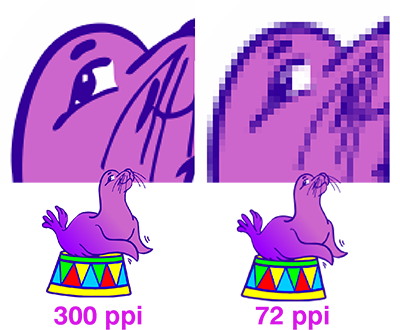
Reverse Image – called "Invert" in some software programs, it is a way to change the colors in a graphic to their opposite, complementary colors. Compare with Mirror Image.
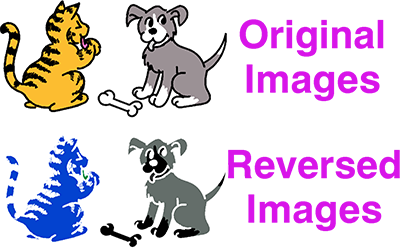
RGB – an acronym for Red, Green, and Blue, the light-based colors used for creating images on monitors and screens. See Additive Color.
Rip – Raster Image Processor. Software used by printers for accurate color separations.
Royalties – a method of payment from a publisher whereby an contracturally agreed upon percentage of the sale price of a published product will be paid to the author and/or illustrator as the product is sold. Royalties from sales are generally dispersed quarterly. See Advance.
SSaddlestitch - describes a type of binding when printed pages, folded and assembled, are stapled along the fold, holding the loose pages together and producing a booklet.
Sans Serif – a typeface that does not have the small flourishes added to the ends of strokes on some typefaces. See also Serif, Font, Typeface, Leading, Kerning.
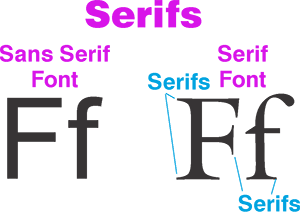
Scale – to re-size a graphic or image by either enlarging or reducing the size, either proportionately or non-proportionately. See Proportionate and Non-proportionate. The Caribbean Man
Score – to make an indention in paper or board along a line where it will be folded, enabling the fold to be cleaner.
Score Marks – on artwork set up for printing, dashed lines that will print outside finished image trim lines that indicate to the bindery department of a print shop where to score or fold the paper.
Screen Printing – a printing method used most commonly in the textile industry, but also for over-sized and specialty printing. Fabrics of various meshes are stretched across wood or metal frames, coated with emulsion, and, using film Positives, the images to be printed are Burned onto the emulsion, which hardens through the clear areas of the film. The unhardened emulsion is washed away, then the dry screen is mounted to the press and a squeegee is used to press the ink through the open areas onto the substrate. Newer technology is slowly replacing the older way, but many t-shirt artists still print using the traditional method. When artists use traditional screen printing methods to print fine artwowrks and reproductions, it is called Serigraphy
Screens – open meshed fabrics of various weights stretched across wood or metal frames used in the Screen Printing process.
Secondary Colors – the colors on a Color Wheel that are made by mixing 2 Primary colors. The 3 Secondary Colors on the Traditional Color Wheel are orange, green and purple. On the CMYK Color Wheel the secondaries are red, green and blue, which happen to be the RGB colors.
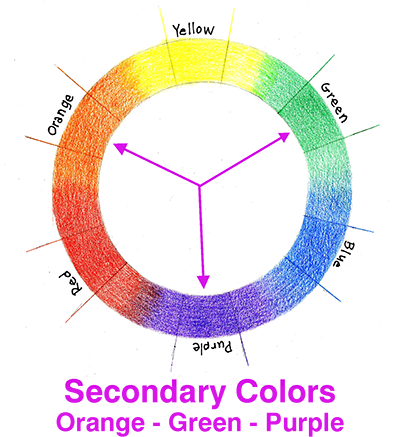
Self Cover – the cover of a bound book or booklet that uses the same paper for the cover as was used for the inside pages. Self covered books generally are printed in signatures, folded, collated for page order, Saddlestitched and trimmed.
Self Publisher – an individual(s) who chooses to publish a work independent of traditional publishing methods. When self-published, the individual who created and published the work generally holds all rights to said work if the work was produced solely by the individual. If the work was produced in tandem with assistance from a self publishing house, that publisher will also benefit monetarily through fees and royalties. See also Publisher, Traditional Publisher, or Vanity Publisher.
Self Publishing House – an establishment set up with the intent to assist self published authors in the process of getting their books published and into bookstores. The author pays for services such as editing, book layout and production, and marketing. WARNING! Authors beware ... there are scammers in the self publishing world ... see warnings under Vanity Publisher.
Separations – manually or electronically providing a printer with each color or page needed for a producing a printed image. Also referred to as Color Separations
Serif – the small flourishes added to the ends of strokes on some typefaces. See also Sans Serif, Font, Typeface, Leading, Kerning.

Serigraphy – refers to Screen Printing when used by artists to create fine art reproductions.
Signature – a printing term, especially in offset printing, referring to multiple pages, generally 4-16, depending upon dimensions of page and paper, that when assembled in correct positions on the printed sheet, can be printed on both sides, folded, and trimmed, and will produce inside pages of a bound book or a Self Covered bound booklet with consecutive pages occuring in the correct order.
Social Media – internet platforms such as Facebook, Twitter, Instagram, YouTube, etc., designed for the purpose of entertainment, sharing information and allowing individuals, organizations, and the general public to interact socially or professionally.
Softcover – a book bound with soft materials such as paper or cloth.
Software – the digital programs installed into your computer that enable you to create and modify graphics, photos and typesetting, play games, listen to music, play videos and movies, etc. See also Hardware.
Spine – in both hardcover and softcover books, the outermost surface of the left bound edge of the book. The number of inside pages, the thickness, weight and type of paper used on inside pages, and the type of binding used, will determine the spine width. Spines with a width of 1/4” or greater can have typed copy on them, such as book title, author, publisher logos, etc.
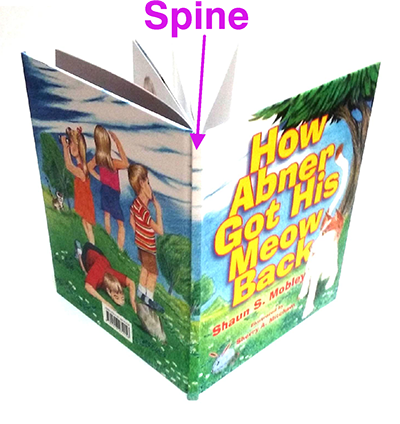
Split Complementary – on a Traditional Color Wheel, a color plus the 2 colors that are adjacent to the complementary color. See also Complementary Colors.
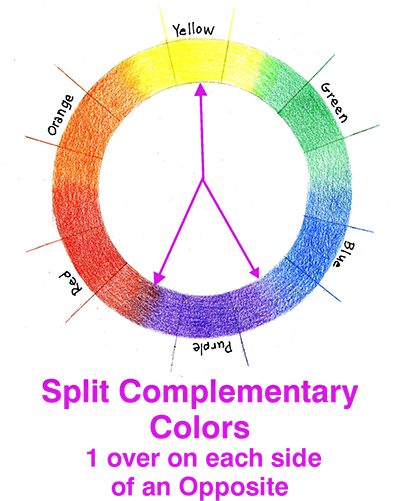
Spread – in a bound book, two facing pages, one on the left side, one on the right side, as a reader will view them when reading said book. See Center Spread.
Spot Colors – pure, exact colors of ink or toner that are not built with a color mixture of two or more other colors, as in CMYK or RGB color models. When printed out as separations, the computer will treat a spot color as its own separation, and will not break it into cmyk, the four-color process colors. For that reason, if the art or graphics will be printed on digital equipment, best results will be achieved if spot colors are converted to CMYK before printing. Spot colors are used for Color Separations for Screen Printing or Offset Printing that will pre-mixed ink colors. See also Pantone Matching System, PMS Color Bridge, PMS Color Guide, PMS Spot Colors, Coated, and Uncoated.
Square Fold - in digital shops, some digital presses are equipped with a feature that, for very thick Saddlestitched books, will actually create 2 folds, very close together, in the center of the page, and then staple the pages. The result closely resembles a perfect bound book, with a narrow spine, and is helpful for reducing the bulk when there are very many pages to fold and staple.
Stop Bath - in pre-computer days, when black and white art was photographed to make negatives to burn plates for the press, the film naturally had to be develped in photographic devleoper. When the image appeared on the film, at the desired level of develpoment, the film would be immersed into the Stop Bath solution to halt any further development of the image. The film was then rinsed in clear water, allowed to dry, and then was ready for the Stripping process.
Storyboard – a one-page layout of all of proposed scenes of a story line that are being planned or considered, to show and plan how the action or story will unfold.Typically associated with the film and television industry and video production, but also useful when planning story books, graphic novels, and theater productions.
Storyteller – similar in the meaning to the term Author, the two terms can be used interchangeably. Generally speaking, however, a Storyteller relates their story orally to listeners, while an Author relates theirs via the written word to readers. Stories from both can be fact-based from actual events in their own or another’s life, or pure fiction, invented from imagination.
Stripping - in Offset Printing, either with a Camera in pre-digital days, or with an Image Setter today, negative images on clear film of each color separation of a graphics file are produced. Then these Negatives are “stripped” or taped onto the back of Masking Sheets using a light table and the printed grid on the sheet for alignment. Openings are cut in the paper from the front to expose the image areas of the negative. A masking sheet with an appropriate film negative is needed for each color to be printed, and they will have to be “registered” or aligned perfectly with each other. These sheets are then used to Burn the Plates for the offset press.
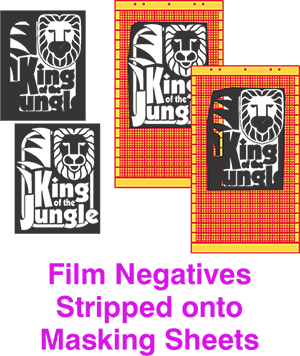
Subtractive Color - color based on pigment and pigment mediums, such as painting or printing. Subtractive colors get darker as more color is added, moving to black. Compare with Additive Color, which is light based.
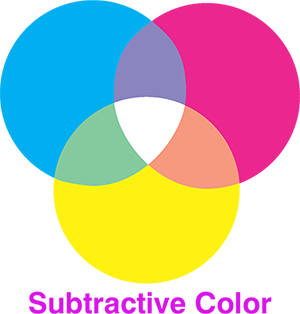
Substrate – a term that refers to any surface that receives a printed image either by being run through a printing press, offset or digital, or by a silk screening method. Generally refers to paper, but can be anything with a surface that can receive a printed image.
TTedious - describes the condition that results while, when illustrating a picture book, attempting to take the very tiny point of a very sharp pencil and proceeding to cover a minimum of 1,612 square inches of smooth bristol board with colored wax-based pigment ten times over, multiplied by the number of illustrations that are needed. Proceed at your own peril.
Tertiary or Intermediate Colors – on a Traditional Color Wheel, one Primary Color and one Secondary Color mixed together. Examples: red-orange, blue-purple, yellow-green etc.
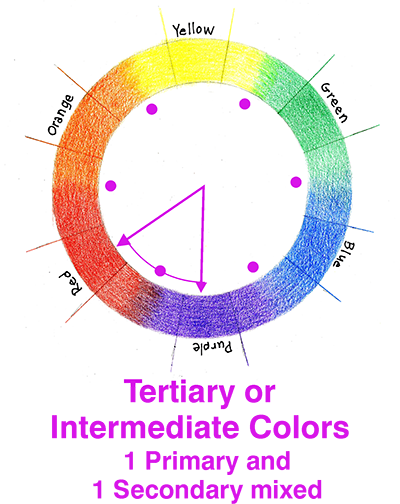
Terror – a strong, negative emotional reaction, generally brought on by exposing an artist or a writer to a blank, white page awaiting marks or words from said persons. See Blank Page entry for explicit warnings.
Tooth – a feature of paper, particulary paper designed for accepting various art mediums, that describes the roughness or smoothness of the paper. Wet mediums like watercolor can saturate the tooth of the paper. Pencil markings tend to sit on top of the tooth, and must be applied heavily to totally cover the paper with pigment.
Tracing – (a) Term describing the action of a computer graphics program when converting a Raster Image into a Vector Image. The program separates the Raster Image into separate colors, and traces a line around each color. (b) In drawing, laying a sheet of paper over an existing image and following the lines of the existing image to draw a copy. Tracing paper can be used or a light table, which will allow the image to be seen on the top sheet.
Traditional Color Wheel – see Color Wheel, Traditional
Traditional Publisher – an establishment that purchases the rights to produce, market and sell works by writers and artists who have submitted said works for consideration for purchase. The writer or artist will receive name credit and monetary reward through royalties for creating the work, but the work in its product form is generally the property of the publisher. See also Publisher, Self Publisher, and Vanity Publisher.
Trap Registration – in graphics prepared for print production, where two or more colors meet at their edges, there is a slight overlap, generally the lighter color under the darker color. Trap registration is most commonly used in traditional offset printing on paper. See also Butt Registration.
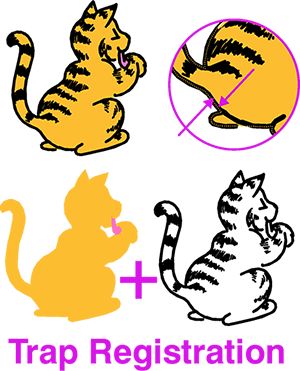
Triad Color Scheme – any 3 colors on the Traditional Color Wheel that are equally spaced from each other on the wheel. Examples: red-yellow-blue; orange-green-purple.
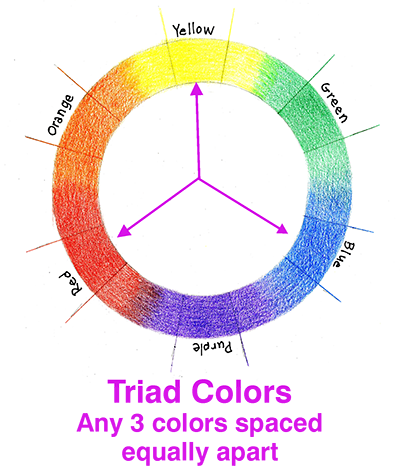
Trim Marks – on artwork set up for printing, solid lines that will print outside the image area to indicate to the bindery department where to trim the printed pages. See also Printer's Marks, Fold Marks, and Register Marks.

Turnaround Sheet – a tool used by illustrators when developing the look of characters by drawing them from various views and positions.
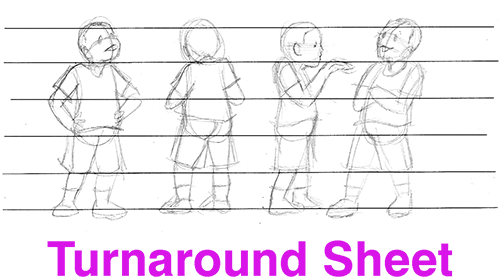
Turner, Joseph Mallord William - British Watercolorist and Oil Painter. Born April 23, 1775, died December 19, 1851. Educated at the Royal Academy in London. The greatest artist who ever walked the planet and who was probably the sole reason why God invented Britain. For those who would argue, did you ever sell a watercolor for over $47,000,000? I rest my case.
Twitter – a social media platform. See Facebook.
Typeface - the general design or style of letters in typed or printed copy. The main and most recognizable being Serif, Sans Serif, and Script typefaces. See Font, Serif, Sans Serif, Leading, Kerning.
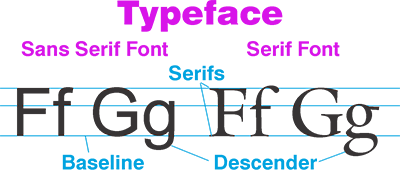
U-V-W
Uncoated Paper – refers to paper which, during manufacturing, has not had any type of finish or coating applied to the surface. Because the surface is not sealed, uncoated paper will have more of a tooth and will be more absorbant than Coated paper, making it a good surface for pencil, pastel and watercolor, but not so much for pen and ink renderings that need to be crisp and sharp. It's also not the preferred choice for high-end offset printing and art reproductions where the images need to be bright and sharp. See also Coated Paper.
Vanity Publishing – a term often confused with Self Publishing, because, unlike Traditional Publishing, the author bears the costs of producing the book. The big difference from Self Publishing is that the Vanity Publisher generally will apply for copyrights and ISBN's and will own all rights to the book, and will keep most of the profits from book sales. A true Self Published author will own the rights to their book. A legitimate Self Publishing House is one who will help and guide an author through the steps – editing, production, marketing, etc. – and will be upfront about what the author is responsible for, what the publisher will provide, who will own rights to the finished work, and how profits will be dispersed. Beware of scammers!! Authors – epecially new authors – can be really emotionally pumped about seeing their new baby on bookshelves and the scammers take advantage of this by making big, sweeping promises up front, then later when the author is too deep into the process to back out, hitting them with unexpected expenses. Put your emotions on hold, put on your professional hat, and NEVER sign contracts until you TOTALLY UNDERSTAND what you can expect from them and what they expect from you, from beginning to end.
Vector Image – an image viewed on a screen or monitor that is math-based. It is constructed by joining straight or curved lines between points or coordinates on a page in a graphics software program. Vector graphics have clean crisp edges that will remain clean and sharp no matter the Resolution and no matter how large or small the graphic is, making vector graphics the ideal choice for typed copy and clip art that will be enlarged greatly for applications such as signage, vehicle graphics, etc. Sign makers and die cutters use vector graphics when creating cut lines around images for for their plotters and cutters. See also Raster.

Vectorize – the act of converting a Raster Image into a Vector Image. Computer graphics programs do this by Tracing around the individual colors of an image.
Voice - the unique style, personality, philosophy, point of view or message creative persons – particularly writers – have that shines through their work, identifying the work as their own. It can also refer to the narrative of a written story, or the speech of particular character(s) in the story. Just the Facts Ma'am
Wave, The – oil on canvas, 1889, 10’x17’, by Russian artist, Ivan Aivazovsky, 1817-1900. Excellent example of an artist who knew how to ride his Pony. A decent substitute if you find yourself currently in the unfortunate circumstance of being unable to view any old scribble by J.M.W. Turner. See Turner, Joseph Mallord William.
Website – a vehicle through which an author or illustrator – in truth, any person or establishment, public or commercial – can broadcast, advertise, interact with and otherwise make available to potential clients, employers and to the public at large, their wares, expertise, talents, skills, thoughts and philosophies for consideration, examination, education, influence and commercial exchange. Utilized properly, many positive results can occur, including, but not limited to, personal growth and satisfaction, increased development and reach of talents and skills, exposure to new opportunities, new people and organizations, and monetary gain. NOTE: Precautions to consider include preoccupation with content and appearance of site, which can result in loss of sleep, skipping of meals, and neglect of important personal and professional responsibilities, relationships, and hygiene. If contemplating launching a website, consider and follow wise advice from the plumbing profession: DO NOT ATTEMPT ON YOUR OWN! HIRE A PROFESSIONAL! The World Wide Web
Work and Tumble – in offset printing, in 2-sided printing, after printing on front side of paper, the paper is turned, end over end to print the back side. The gripper edge on the second side will be the opposite gripper edge of first side. Also called "Head-to-Tail". Compare with Work and Turn.
Work and Turn – in 2-sided printing, after printing on front side of paper, the paper is turned, side over side to print the back side. The gripper edge on the second side will be the same gripper edge as first side. Also called "Head-to-Head". Compare with Work and Tumble.
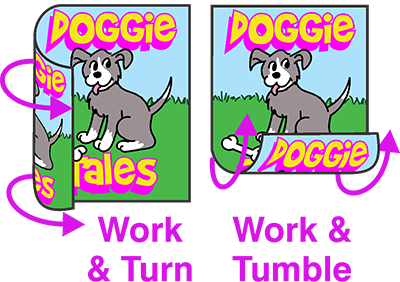
Wrap Around Cover – when the back cover, the Spine, and the front cover of a book are all printed together adjacently on one piece of paper, The spine area is glued or otherwise attached to the inside pages, binding the book together. Softcover and Paperback books are generally wrap around covers.
Writer's Block – also referred to as Block or Creative Block. Refers to what's happening in a creative's brain when the ideas stop flowing and they just don't know what to write/draw/sculpt/compose, etc. next.
X-Y-ZX-Acto Knife – a craft/art/hobby knife with replaceable blades of different shapes for various uses.

YouTube – a social media platform based on members uploading videos in most any genre, created by both professionals and amatuers, in the hopes of gaining followers and subscribers. For viewers it's a great place for entertainment, education, enlightenment, and goofing off when you should be doing other more important things. When you get tired of merely watching, launch your own channel and then we can all watch you!